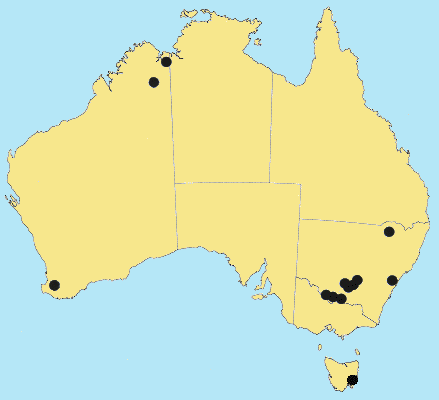Echinochloa oryzoides* (Ard.) Fritsch. Verh. Zool.-Bot. Ges. Wien 41: 742 (1891).
Classification. (GPWG 2001) : Subfamily Panicoideae. Paniceae.
Basionym and/or Replacement Name: Panicum oryzoides Ard., Animadv. Bot. Spec. Alt. 2: 16, pl. 5 (1764).
Type of Basionym or Protologue Information: Semina hujus Panici inventa a me fuere inter Oryzam,.
Key references (books and floras): [2002] D.Sharp & B.K.Simon, AusGrass, Grasses of Australia, [2008] S.W.L.Jacobs, R.D.B.Walley & D.J.B.Wheeler, Grasses of New South Wales (228).
Illustrations: [2008] S.W.L.Jacobs, R.D.B.Whalley & D.J.B.Wheeler, Grasses of New South Wales, 4th edn (228).
Habit. Annual. Culms erect, 25–150 cm tall, 4–6 -noded. Leaf-sheaths glabrous on surface. Ligule absent. Leaf-blades 7–35 cm long, 4–12 mm wide. Leaf-blade surface smooth.
Inflorescence. Inflorescence compound, a panicle of racemes. Racemes 2–5 cm long. Central inflorescence axis 6–25 cm long.
Spikelets. Spikelets sessile. Fertile spikelets 2-flowered, the lower floret barren (rarely male), the upper fertile, comprising 1 basal sterile florets, comprising 1 fertile floret(s), without rachilla extension, elliptic or ovate, dorsally compressed, 3.8–6.5 mm long. Rhachilla internodes brief up to lowest fertile floret.
Glumes. Glumes dissimilar, thinner than fertile lemma. Lower glume ovate, membranous, without keels, 3–5 -nerved. Lower glume surface indumented. Lower glume apex mucronate. Upper glume ovate, 4.1–5.5 mm long, membranous, without keels, 5 -nerved. Upper glume surface indumented. Upper glume apex mucronate or awned. Florets. Basal sterile florets 1, barren, with palea or without significant palea. Lemma of lower sterile floret 100 % of length of spikelet, membranous or chartaceous, 5 -nerved, muticous or awned.
Fertile lemma 3.5–5 mm long, without keel, 5 -nerved. Lemma apex mucronate. Anthers 3. Grain 2.5–3.5 mm long.
Continental Distribution: Europe, Africa, Temperate Asia, Tropical Asia, Australasia, Pacific, and South America.
Australian Distribution: Western Australia, Queensland, New South Wales, Tasmania.
Western Australia: Gardner. Dale. New South Wales: Central-Western Slopes, South-Western Slopes, South-Western Plains.
Notes. Echinochloa oryzoides is probably a selected variant of E. crus-galli, from which it is differentiated on the size of the spikelet and grain. The distinction between E. oryzoides and E. phyllopogon is not clear.
Introduced. Echinochloa oryzoides vegetatively mimics rice and occurs in most of the rice-growing areas of the world. In dry sclerophyll forests, tropical and subtropical sub-humid woodlands, temperate sub-humid woodlands, and semi-arid shrub woodlands. Flowers Jan.-Apr.




